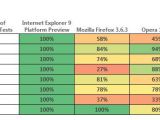Internet Explorer 9’s evolution with the release of Platform Preview 2 is illustrative of the work the company is doing with the goal of achieving “same markup” across all browsers. But same markup (the same HTML, same CSS, and same script working seamlessly across all browsers) is not just about the Redmond-based company. It’s also about developers, standard bodies, the World Wide Web Consortium (W3C), and rival browser makers. Same markup is bound to make more sense to developers than to end users, IE9 Preview 1 and 2 are, after all, developer releases. The public needs to think of “same markup” in terms of interoperability, meaning that a website, any website, should work the same across any browser they run.
Browser interoperability is, as a general rule, a multi-way street and a multi-faceted problem. If it really didn’t seem so thus far is because of nothing more than aggressive marketing from a few players on the market. And let’s be fair, because Internet Explorer provided such an excellent target to blame for everything that was wrong with the web. But what if, one day, IE simply fell in line? Will the world (www) be ready to accept that browser interoperability comes with many, subtle nuances, which can be solved only through collaboration? Let’s hope so.
“Enabling an interoperable web so developers can create amazing HTML5 applications is at the core of what ‘same markup’ means. Our investments in standards and interoperability are all about enabling the same markup to just work. When developers spend less time re-writing their sites to work across browsers they have more time to create amazing experiences on the web,” revealed Dean Hachamovitch, General Manager, Internet Explorer.
IE9 is catching up
It might have taken Microsoft more than other browser vendors, but the company is indeed catching up. A market share slice the size of Internet Explorer’s inherently comes with barriers limiting just how far innovation can go, in the context in which the vast majority of customers expect the software to simply work, just like it did before, and with as little changes as possible. This, combined with the company’s “insistence” on not breaking the web, slowed down the evolution of IE in aspects such as web standards support, in the past.
With an Acid3 Test score of 68 out of 100 for Platform Preview 2, and closing in on the perfect 100/100, Internet Explorer 9 is catching up. But Microsoft is doing much more than tailoring IE9 to Acid3. The company submitted some 192 tests to W3C. 192 new tests, which IE9 has no problems passing, while the same is not valid for Firefox 3.6.3, Chrome 4.1, Opera 10.52, Safari 4.05. In all fairness, especially with the new tests, browser makers still need time to tweak their products.
“We’re engaged with the standards working groups and other browser vendors as part of the web community with Same Markup as a key goal. Same markup is the real-world benefit of standards for developers (and through them, the rest of the web),” Hachamovitch said. “True standards bodies are important so that different parties and communities can come together to consensus. Specifications are a good start. Other parts of the technology industry have shown that comprehensive and accurate test suites are essential to provide interoperability for developers and products that work for consumers. They’re how an industry converges on a common understanding of the specifications and can assess its progress.”
Going beyond Acid3
It’s not just Microsoft that needs to change the code for IE. Google, Mozilla, Opera, Apple, etc. need to do the same with their respective browsers. The image to the left is a summary of how the latest stable releases of Firefox, Opera, Safari, and Google are interoperable with IE9 in terms of the tests Microsoft submitted to the (W3C) working groups (more info here). As you can see, when it comes down to the 192 test cases from the Redmond-based company, it is Google, Mozilla, Opera and Apple that need to change their code, and catch up.
While Acid3 does serve its purpose, it is limited in the testing of standards support, because it focuses on a limited number of details, about 100, and looking only at a dozen different technologies. Another downside of Acid3 is that some tests involve standards that are still being developed, with inherent problems and conflicts. This could easily lead to situations in which browsers focus on scoring 100/100 in Acid3, while ignoring other aspects of modern web standards, and not being truly interoperable.
“Web browsers should render the same markup – the same HTML, same CSS, and same script –the same way. That’s simply not the case today. Enabling the same markup to work the same across different browsers is as crucial for HTML5’s success as performance,” Hachamovitch added. “While some people associate this same markup situation with IE6, it actually applies across browsers in general. Developers typically have to write different markup to get the same desired outcome, even across the latest versions of Firefox, Chrome, and Safari browsers.”
Take a look at the videos embedded below. With the advent of IE9 Platform Preview 2, Microsoft has released three videos highlighting the differences in standards implementation between browsers. There are various browsers demoed, some of which already pass the Acid3 Test, while they are not interoperable in the true sense of the word. Simply because standardization across all browsers needs to be more than just Acid3.
Internet Explorer 9 (IE9) Platform Preview 2 Build 1.9.7766.6000 is available for download here.
Internet Explorer 8 (IE8) RTW is available for download here (for 32-bit and 64-bit flavors of Windows XP, Windows Vista, Windows Server 2003 and Windows Server 2008).
Firefox 3.6.3 for Windows is available for download here.
Google Chrome 4.1 Stable is available for download here.
Opera 10.53 is available for download here.

 14 DAY TRIAL //
14 DAY TRIAL // 
